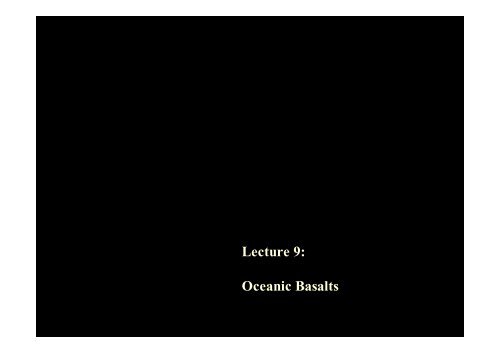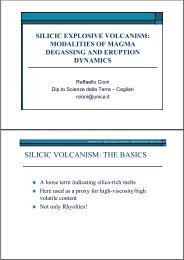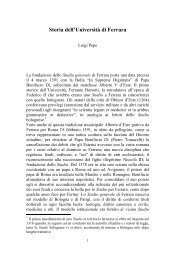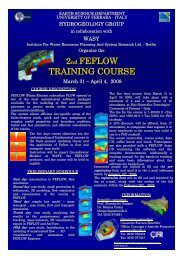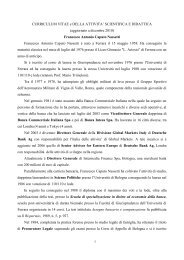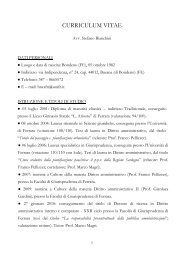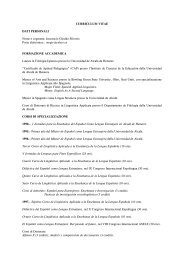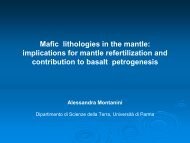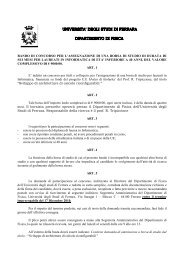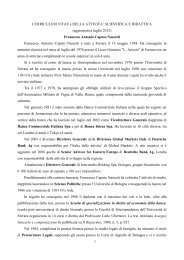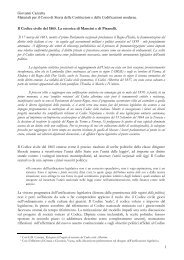Lecture 9: Oceanic Basalts
Lecture 9: Oceanic Basalts
Lecture 9: Oceanic Basalts
You also want an ePaper? Increase the reach of your titles
YUMPU automatically turns print PDFs into web optimized ePapers that Google loves.
<strong>Lecture</strong> 9:<br />
<strong>Oceanic</strong> <strong>Basalts</strong>
So-called “spidergrams” – concentration normalised to estimate of “primitive<br />
mantle”.<br />
Mostly chondrite-normalised except for volatile elements<br />
Incompatible Compatible Unusual<br />
to plot<br />
major<br />
elements
Rb, Sr, Nd and Sm are all incompatible during mantle melting i.e. they<br />
partition preferentially into the melt phase.<br />
Nd is more incompatible than Sm and Rb is more incompatible than Sr<br />
Normalised<br />
Concentration<br />
Source<br />
1<br />
Melt<br />
LaNd Sm<br />
Rb Sr<br />
Lu<br />
Residue<br />
1<br />
1<br />
La Nd Sm Lu<br />
Rb Sr<br />
Low Sm/Nd ► low 143 Nd/ 144 Nd<br />
High Rb/Sr ► high 87 Sr/ 86 Sr<br />
La Nd Sm Lu<br />
Rb Sr<br />
High Sm/Nd ► high 143 Nd/ 144 Nd<br />
Low Rb/Sr ► low 87 Sr/ 86 Sr
0.5130<br />
0.5120<br />
ε<br />
143<br />
Nd = {<br />
Nd/ 144 Nd s -1} x 10 4<br />
143<br />
Nd/ 144 Nd CHUR<br />
0.5110<br />
Residual mantle<br />
143 Nd/<br />
144 Nd<br />
0.5100<br />
0.5090<br />
0.5080<br />
Partial melts of<br />
the mantle have<br />
lower Sm/Nd than<br />
their sources<br />
because D Nd<br />
Concentrate solely on oceanic basalts:<br />
No possibility of sampling continental material en<br />
route to eruption – any isotopic variation observed<br />
can be safely attributed to the mantle source<br />
Two main classes of oceanic basalts:<br />
Mid-Ocean Ridge <strong>Basalts</strong> – MORB<br />
Ocean Island <strong>Basalts</strong> - OIB
Basalt & Source<br />
La Lu<br />
MORB<br />
Melts have high Rb/Sr and low<br />
Sm/Nd, so evolve high 87 Sr/ 86 Sr<br />
and low 143 Nd/ 144 Nd<br />
143<br />
Nd/ 144 Nd<br />
Depleted<br />
Quadrant<br />
CHUR<br />
Residues have low Rb/Sr and<br />
high Sm/Nd, so evolve low<br />
87<br />
Sr/ 86 Sr and high 143 Nd/ 144 Nd<br />
or ε Nd<br />
Continental<br />
Crust<br />
High 143 Nd/ 144 Nd – ancient<br />
LREE depletion<br />
Enriched<br />
Quadrant<br />
La<br />
Lu<br />
Low 143 Nd/ 144 Nd – ancient<br />
LREE enrichment<br />
87<br />
Sr/ 86 Sr<br />
or ε Sr
MORB –<br />
Relatively homogeneous source.<br />
Depleted in incompatible elements and 87 Sr/ 86 Sr and<br />
143<br />
Nd/ 144 Nd indicate ancient “time-integrated”<br />
depletion.<br />
MORB sample upper mantle that was depleted in<br />
incompatible elements by the extraction of the<br />
continental crust.<br />
Upper mantle represents the complementary reservoir<br />
from which continental crust was extracted.
Source<br />
Basalt<br />
MORB<br />
La<br />
OIB<br />
Lu<br />
La<br />
Lu<br />
Many OIB fall between CHUR<br />
and MORB implying a source<br />
that is depleted relative to<br />
CHUR but less depleted than<br />
the MORB source.<br />
143<br />
Nd/ 144 Nd<br />
or ε Nd<br />
Depleted<br />
Quadrant<br />
CHUR<br />
Continental<br />
Crust<br />
Enriched<br />
Quadrant<br />
La<br />
Lu<br />
However, OIB magmas tend<br />
to be enriched in<br />
incompatible trace elements<br />
So, Rb/Sr and Sm/Nd<br />
observed in OIB do not<br />
reflect the “time-integrated”<br />
Rb/Sr and Sm/Nd of the OIBsource<br />
mantle represented<br />
by the isotope data.<br />
87<br />
Sr/ 86 Sr<br />
or ε Sr
OIB –<br />
Source<br />
La Lu<br />
LREE depleted<br />
Basalt<br />
La Lu<br />
LREE enriched<br />
Apparent paradox is mainly due to<br />
differences in the degree of partial<br />
melting.<br />
If OIB represent small melt fractions<br />
than MORB, then even a relatively<br />
depleted source can yield LREEenriched<br />
melts – especially so if<br />
melting starts in the garnet field<br />
because HREE are compatible in<br />
garnet.<br />
However, isotope data still indicate<br />
that OIB sample (or preserve) a<br />
greater variety of mantle<br />
heterogeneity.
MORB<br />
OIB<br />
143<br />
Nd/ 144 Nd<br />
Depleted<br />
Quadrant<br />
CHUR<br />
or ε Nd<br />
Enriched<br />
Quadrant<br />
Continental<br />
Crust<br />
87<br />
Sr/ 86 Sr<br />
OIB MORB<br />
Continental<br />
Crust<br />
or ε Sr<br />
650 km<br />
Transition<br />
Zone<br />
<br />
Depleted<br />
Upper Mantle<br />
Primordial<br />
Lower Mantle
DMM<br />
CHUR<br />
HIMU<br />
EM2<br />
EM1<br />
From: Hofmann, Nature 385, 219-229 (1997)
OIB Andean Margin MORB IAB OIB<br />
Well Stirred<br />
Depleted Upper<br />
Mantle<br />
Recycled<br />
Ocean<br />
Crust<br />
Less Well<br />
Stirred<br />
Ancient “streaks”<br />
And “blobs”
Eiler et al. (1996) Geochim Cosmochim Acta 61 2281-2293
143 Nd/<br />
144 Nd<br />
OIB<br />
Peridotite<br />
Massifs<br />
87<br />
Sr/ 86 Sr<br />
Zindler & Hart (1984) Annu. Rev. Earth Planet. Sci. 14, 493-571
Continental Crust
15.70<br />
15.60<br />
15.50<br />
15.40<br />
15.30<br />
8.5<br />
Northern Hemisphere Reference Line<br />
8.4<br />
Geochron<br />
8.3<br />
Δ7/4<br />
μ = 8.2<br />
17.0 17.5 18.0 18.5 19.0 19.5 20.0 20.5<br />
206 Pb/<br />
204 Pb<br />
207 Pb/<br />
204 Pb
The DUPAL Anomaly<br />
Δ7/4 > 11<br />
Δ7/4>3<br />
Δ7/4 > 7<br />
Hart Nature 309, 753-757 (1984)
Mantle Models<br />
Fine scale<br />
heterogeneity<br />
Large scale<br />
layering<br />
Zindler et al (1984) Earth Planet. Sci. Lett. 70, 175-195
250<br />
N<br />
200<br />
150<br />
MORB<br />
100<br />
50<br />
OIB<br />
Primordial<br />
He > 50 R a<br />
0<br />
10 20 30<br />
3<br />
He/ 4 He (R/R a )<br />
MORB = 8 ± 2Ra<br />
Some OIB (though by no means all) > 8 Ra
The Geochemical “Standard Model”<br />
Continental Crust<br />
&<br />
Lithospheric Mantle<br />
Best estimates suggest only 1/3-1/2 of<br />
mantle is depleted to form Continents.<br />
Depleted Upper Mantle<br />
Source of MORB and<br />
apparently devoid of high<br />
3<br />
He/ 4 He<br />
Primitive Lower Mantle<br />
Somewhere there is a source of<br />
primitive He which suggests<br />
mantle that has never melted
Kárason & van der Hilst (2000)<br />
AGU Monog. 121, 277-288
Kellogg et al. Science 283, 1881-1884 (1999)
A Numerical Model<br />
(Van Keken and Ballentine 1998; 1999)<br />
Mid Ocean<br />
Ridges<br />
Formulation:<br />
330,000 Tracers<br />
U+Th+K production of Heat, Ar and He.<br />
Degassing<br />
Phase changes and P,T dependant rheology<br />
Internal heating and U+Th concentration<br />
Secular cooling of mantle and core<br />
Benchmarks<br />
Surface heat flow<br />
Plate velocity<br />
Viscosity profile<br />
Caveat<br />
Not spherical<br />
Low effective temperature dependence<br />
No continental crust formation
What we think we know:<br />
The depleted upper mantle is broadly complementary to the continents.<br />
The uppermost mantle (MORB source) is fairly homogeneous and<br />
devoid of primordial He.<br />
The OIB source is more heterogeneous and includes both enriched and<br />
primordial material.<br />
Possible enriched components include subducted ocean crust,<br />
terrigeneous and pelagic sediments, delaminated continental mantle<br />
and intra-mantle differentiates.<br />
The heterogeneities need to persist for Ga to evolve their isotopic<br />
signatures. Until recently this was thought to require them to be large<br />
but this is now less clear.<br />
A source of high 3 He/ 4 He is required and this is most likely primordial<br />
mantle that has never melted. Whether this is a discrete layer or<br />
admixed into the mantle remains controversial


